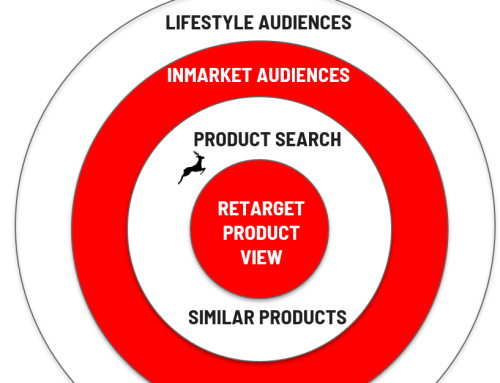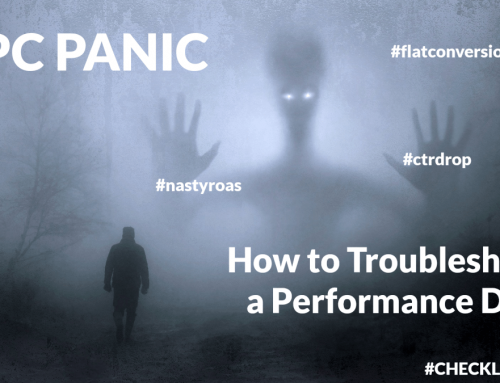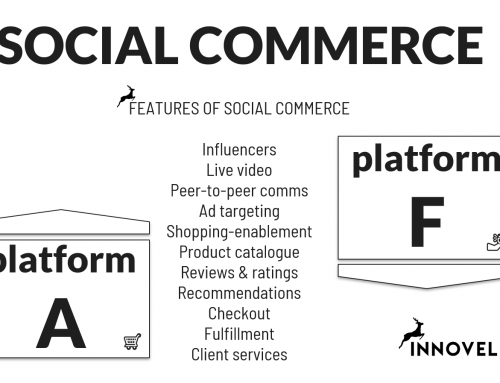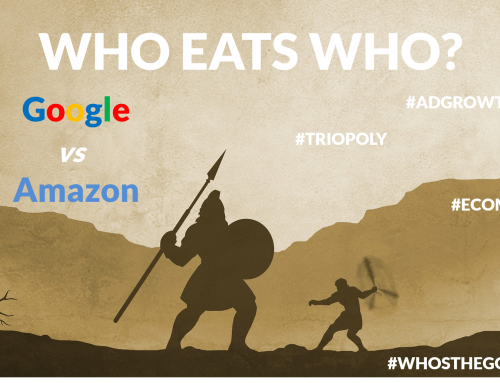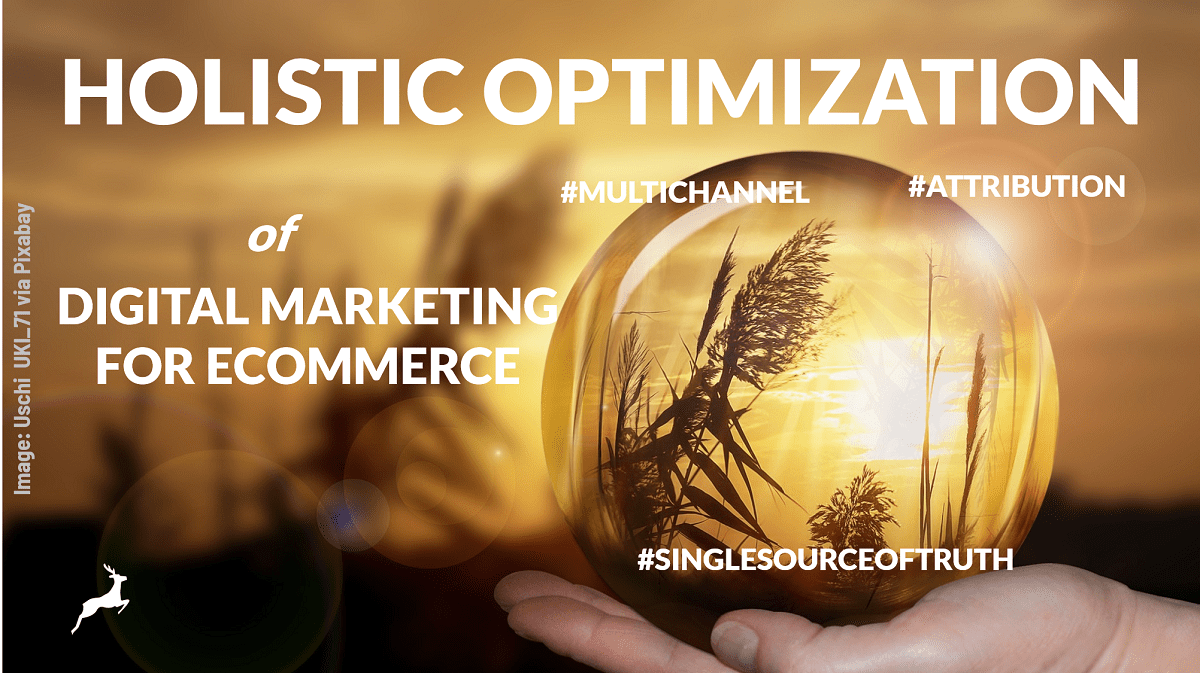
Holisitic Optimization of Digital Marketing for Ecommerce
If you are spending less than 8% of your sales on advertising, you may be underspending! Digital Advertising is driven by Ecommerce. And perhaps a little by branding, which is financed by commerce too. Global Ecommerce was over 4 trillion dollars in 2020 (statista). Comparatively speaking, digital advertising is a midget, at 330 billion. So, global digital advertising as a proportion of global ecommerce is 8%. There is your benchmark, but how should you spend your advertising budget?
Spending where it works
Wanamaker famously said that one half of advertising spend is wasted, the trouble being that you don’t know which half. Fortunately, we are now in the world of digital advertising where everything is measurable, right? If only it were that easy. As we have undercovered in the Digital Marketing Report, all marketing decisions are taken on the basis of partial data: incomplete, unreliable, unshared, adblocked, webproxied, wrongly attributed. All digital marketers know this, most advertisers too, the majority of end-users don’t. “When I enter information into a website, why should it be shared with all those other sites?” – well it isn’t. Apple’s current advertising is about removing all the other platforms’ partial data collection so that only Apple can monetize that data. Logical movement of troops in the what we call the Data Wars, but not motivated by Apple wanting to protect it’s users, in my opinion.
When marketers look at data from the big marketing platforms, there can be biais in the interfaces too. Did you know that Google analytics shows “sampled results” over a certain threshold of data volume: you see a simulation of what data trend is in your activity, not real data. Explain that to your CFO, will you? Newer concepts such as “data-driven attribution” and “modeled conversions” are pushing in the same direction of predicted data rather than real data.
And most platforms are excellent at pushing their collection of packaged data to marketers. The big platforms are marketing data to their clients, the marketers, using great packaging, promotional outreach, gamification. Dear marketer, did you not know realize that it is you the target audience?
Digital media spend is biaised to promotion
The most reliable data, is found when a marketing operation is carried out exclusively on one platform, and when the path between product discovery and the final purchase is short and uncomplicated. The longer the path gets and the more complex the decision-taking, the less reliable the data tends to be.
Unsurprisingly therefore, Amazon is booming. It is concentrated on the final path to purchase. Also unsurprising, retargeting works really well. Both are close to the measurement point for your sales KPI. And a well-known observation from search marketers, “brand keywords convert”: first users search for category words and when they have found the brand they want to buy from, they search for the brand name. For this reasons, brand keywords are more often attributed the sale.
This challenge of “attribution” has a huge impact on the way budgets are engaged. The data is biased, and subsequently, so are budgets.
In many cases, the data doesn’t tell the story of what happened before the final conclusive action that made a user purchase. Whether this was other keywords that were searched for, or how the person you retarget was identified in the first place. If you really want to optimize your marketing investment, you must look at your entire marketing and communications operation holistically from end-to-end.
Understanding the user journey
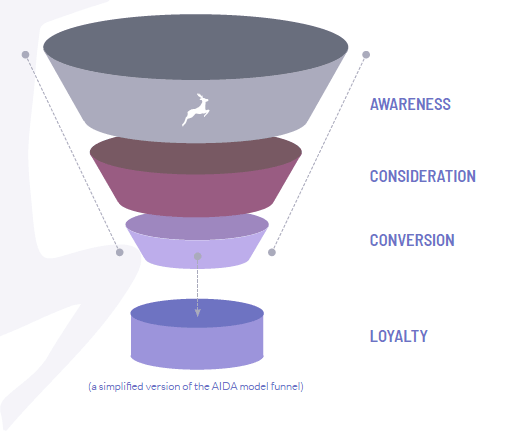
Heard of the “funnel” for digital advertising? It was invented in 1898 so predates most digital marketing by a century. Kind of old and outdated, right? Or maybe it isn’t.
The reference concept behind the funnel is the AIDA model. It is a “hierarchy of effects” model in which users are described as moving through stages before buying a product. Awareness, Interest, Desire, Action. The funnel model is for digital marketers, what the “economic man” model is for economists. The economic man model explains that people make rational purchase decisions and will be more likely to buy a cheaper product than a higher priced similar product.
The funnel model, explains how a user goes through various stages before coming to a decision to buy a product, including becoming aware of the products’ existence, understanding it’s characteristics and finally acting on an impulse to buy it.
Marketers instrumentalize the funnel model to create “awareness” around a product to target audiences, then provide them all the product information they need in order to appreciate and consider buying it. This drive through the funnel is designed to persuade and eventually incite users to buy the product. Here is a more detailed walk-through of digital marketing mechanisms and the stages of the user journey.
Opportunistic marketing
In the TV age, there were few but powerful marketing channels and few but powerful distribution systems. Optimization cycles were long. Study the market, build a creative concept, produce assets, run the campaign flight, stock up in distribution channels, analyse communication and sales results post-campaign. Marketing was a high budget, high risk and high returns business.
In the digital age, marketing channels are fragmented and fast. So are distribution channels. And user behaviour can be erratic too. It has become less risky but more confusing to be a marketer. You can trial and error, you can seize opportunities as they arise. If you are doing no marketing whatsoever, your first action can drive amazing results, and subsequent additional actions can have seemingly no effect. Worse, you can run a number of parallel marketing activities and find conflicting conclusions in the data sets.
What happens when you optimize holistically?
Because of this opportunistic marketing behaviour, the bigger picture is often lost of sight. Applying a funnel view of marketing activities can help identify bottle necks or explain why performance diminishes over time. The key to holistic optimization is to keep an eye on your total investment and your total outcome. It doesn’t have to be 8%, it really depends on what is profitable for your business. It also depends on your goals: if you want to win more marketshare, you should probably spend more than your competitors. If you have a strong brand, perhaps you can get away with spending less to maintain your market share.
With your eyes fixed on that overall performance, you can now look into individual channels and opportunities. It is quite common to see advertisers spend a lot of their budget at the bottom of the funnel, because it is measurable and gives the illusion of high performance. But in some cases, bottom of funnel budgets are cannibalising what we call “organic” performance. You put an ad up and it drove the sales, but the user was going to buy the product anyway. And sometimes you can end up bidding up your own marketing in other channels or perhaps your distributors’ marketing costs for selling your products.
If you think this may be the case in your marketing set-up, try moving some of your budget up the funnel. Reach your target audiences on facebook, target category keywords in search and promote your brand on Amazon. This can stimulate overall performance and allow you to generate better results holistically.
Don’t trust channel-specific performance
One of my favourite films is Minority Report. It depicits a society where truth is established in a closed room where three extraordinary beings can see what will happen in the future. Except, sometimes they don’t agree, and one of them will disagree to generate a minority report.
This can be compared to marketing reports emanating from one marketing channel. All the data isn’t there, but the truth that emerges seems compelling, whereas in reality it is incomplete and sometimes even false.
Everything is measurable in digital marketing, except for all the incomplete data, the biaised data, and the fact that advertising platforms are marketing their product to the advertiser without disclosing their minority reports.
Only a holistic view of all marketing activities can help you learn what balance of media spend and channels works for your brand, so check with your CFO before signing off on the next advertising opportunity you are presented with, and take a chance on channels that make sens from a funnel perspective. They may be more inclined to drives results in the long run.


